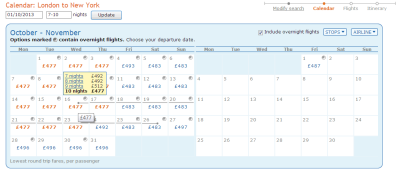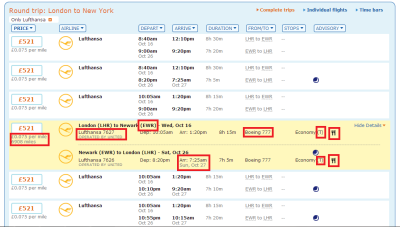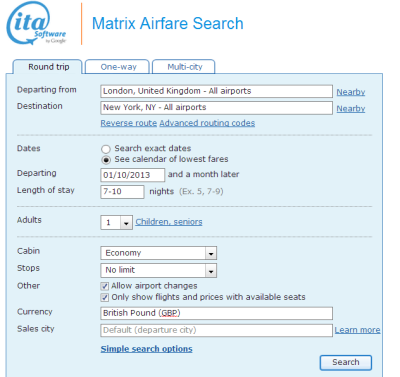How I use ITA Matrix to find the best value flights (Part 1)
Step 1: Why are you searching for the flight?
This question is actually deeper than it looks. Are you looking for:
- the cheapest flight? (Note that ‘cheapest' and ‘best value' are not the same. On the cheapest tickets you might not get as many air miles as a slightly more expensive ticket which might be better value. If you can understand this point then you can easily crack the air miles game!)
- flights on a particular airline(s)?
- flights with particular stopovers/transfer or a particular route? (My post on maximising MPM may help too)
- a mileage run? (or any other trip whose sole purpose is more air miles or elite status)
There are probably as many reasons for buying a flight as people in the world, but you get the idea: adapt your search as necessary!
Step 2: Simple search for your flight (no advanced tricks yet!)
I always start off with a simple search so I know what I'm comparing against. This is very important for if you make any adjustments.
I have three main ‘home' airports. London Heathrow (LHR), London City (LCY) and London Gatwick (LGW) (though I'll soon be adding Amsterdam Schiphol (AMS) to that list). Since London is a multi-airport city, it has its own special internationally-recognised airport code to include all airports in the city — LON.
Some examples of other popular multi-airport codes: Paris (PAR), Berlin (BER)*, New York (NYC), Chicago (CHI), Tokyo (TYO). *BER will stop being the multi-airport code for Berlin and will be the sole airport code for the new Berlin Brandenburg airport when it finally opens.
For example I'll look for a London to New York round trip for some point in October 2013. First thing I do is search for available fares using the two cities. The boxes are pretty self-explanatory, so you should have no problems on the first page. One thing I'll add is that you can type it out city names in full (e.g. “London” and “New York”) or airport codes (e.g. “LON”, “NYC”, “LHR”, “JFK” and so on). You get used to conversing in airport codes pretty quickly!
For dates, unless I'm restricted to one or two days for a flight, I'll usually choose to “see calendar of lowest fares”. If you use this option you will need to use the “Length of Stay” box. Bear in mind you don't have to type in a single number like “12” nights, but you can use a range like “7-10” nights. Though If you use the range option there is a limit of 7 nights between minimum and maximum.
For currency, I will always force my search into British Pounds. So here I type “GBP”. You can do it with any other currency like “EUR”, “USD”, “HKD” etc. (If you leave it blank it defaults to the departure country's currency, which in this case is GBP so wasn't necessary for this step, but I do it to maintain good habit).
This is what my search screen looks like before I click “Search”:
And after I click “Search” it shows me a calendar of dates and prices.

And once I click on a date then it will bring me to the next page which contains the fare matrix (the crux of its name!)
And just beneath it, a list of possible itineraries. It will default to the cheapest flight first.
I like the look of those Lufthansa fares (both one stop and non-stop) so I'll click on the link above Lufthansa's logo to force it to show their flights only. If I hover over the area to the right of the itineraries and then click it, it will give me some details about the flight. I'll take a quick look for anything significant, for example: fare bucket (sometimes called fare code or fare type), tight connections, time differences, very short/long flights, aircraft type, aircraft operator (it will only say this if it is a codeshared flight). I've highlighted the things that I've spotted in the £521 non-stop fares which I think are significant.

Let's work from left to right. The first red box gives me the price per mile. This fare is roughly 7.5p per mile, which if I were doing a mileage run would be way over-priced already. Mileage runs should try to have a maximum of 2.5p per mile if it's for elite status, and less than 1p if it's for redeemable air miles. But let's say I have to take this flight on that day and is acceptable for now, and move on.
The next box says that even though it's a Lufthansa coded fare, it's actually operated by United. Note the prices offered by United in the Matrix earlier were £5 cheaper! Good thing I spotted this one huh?
Next says my arrival airport in New York is EWR, which is Newark Liberty Airport. I usually go through JFK instead of EWR so I would take note of this. Equally if you usually use LGW or LCY instead of LHR you would probably have taken note of the departure airport too.
The arrival time of my return leg. Don't forget there is a 5 hour time difference between New York and London, so you might arrive the next day in local time! Also because it arrives on a Sunday morning, I know Transport for London usually closes some underground lines over the weekends. They spare no mercy for Heathrow sometimes!
Both outward and inward flights will be operated on a Boeing 777, which is a wide-bodied, single decker, long haul aircraft. Not that interesting for this flight, but sometimes you'll see a Boeing 747, Airbus A380 or other interesting aircrafts.
The fare bucket for this particular fare is “T”. Depending on who your collect your air miles with, each airlines has its own rules about how many air miles are awarded for a particular fare bucket, so you need to look it up carefully. Usually if you visit your airline's frequent flier programme and click on something like “Earn miles” or equivalent (there might be an additional page for their “partners” or equivalent) then you need to check how many miles you will get. Note the amount you get could depend on the operating carrier (in this case United because it's their plane I will be sat in), or the marketing carrier (the airline whose flight code it is, in this case Lufthansa as the flight code begins with LH). Here's a link that explains the difference in more detail.
It is critical that you find out if it's the operating or marketing carrier that counts. As a general rule, Oneworld and Skyteam alliance airlines credit miles according to the marketing carrier, and Star Alliance on the operating carrier. Double check with your frequent flier programme though.
And finally I can see there is free food on board 🙂
If I click on the price left of that itinerary it'll take me to the next page which gives me the itinerary again plus its full price breakdown. Once again I'll scan the breakdown for significant details. This time I'll work top left to top right, then down:
Looking at the first red box in “Fare 1” and the corresponding box in “Fare 2”, this pair indicates the fare bases. As a basic simplification, this is the thing that changes if you buy different types of economy, business or first class tickets. This is the thing that brings up the cost if you delay buying your ticket. Whilst this might change, the other taxes mostly remain the same, though with certain exceptions. The fare bucket is always the first letter of the fare basis. I notice that even though the fare bucket is the same for the outbound and inbound legs, the fare basis is not the same. Without checking the fare rules, I imagine this is due to weekday/weekend price differences.
Next, the link to the fare basis rules. You can click this link if you want to read the rules that govern your ticket. This will be important for later stages. But for now let's skip it.
Next we have the price of the two fares. I keep either a mental or written note of the total of the base fares as a ratio of the total airfare and taxes.
To the right of the prices are just two key bullet points from the fare rules. If it's a flexible or refundable fare then you won't see this.
From here onwards we will be dealing with taxes, fees and surcharges. The reason I've only highlighted some is because these are the ones which are avoidable or can be minimised through clever tricks and routings.
“YQ”, sometimes written “YR” is often accompanied by the words “fuel surcharge”. Don't worry if it's not. But you can see here that the fuel surcharge is often more expensive than the base fare! I personally think this is heinous. I'll try to justify it in a rant or another post at some point but let's move on.
Air passenger duty (APD). Read this post to find out how to minimise or dodge this bullet.
UK Passenger Service Charge. This is the money that you pay to Heathrow Airport. You can only reduce this amount by not using Heathrow!
The final box is the total amount per passenger. This one needs no explanation.
That concludes the simple search. It usually takes me around 30 seconds to do all of the above (!) but that has come through practice. You should be able to do everything within around 2-3 mins to begin with, but do take extra time to familiarise yourself with how the fare matrix works. Like I say, it's amongst the most powerful tools you'll come across, especially when you add multi-airport searches and advanced routing codes in the next steps…
to be continued…



